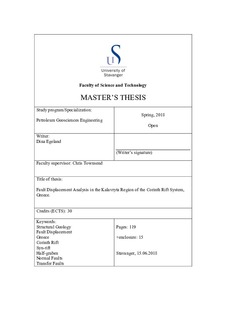| dc.contributor.advisor | Townsend, Chris | |
| dc.contributor.author | Egeland, Dina | |
| dc.coverage.spatial | Greece, the Corinth Rift | nb_NO |
| dc.date.accessioned | 2018-09-17T13:30:53Z | |
| dc.date.available | 2018-09-17T13:30:53Z | |
| dc.date.issued | 2018-06-15 | |
| dc.identifier.uri | http://hdl.handle.net/11250/2563006 | |
| dc.description | Master's thesis in Petroleum Geosciences Engineering | nb_NO |
| dc.description.abstract | The Corinth Rift of Central Greece is one of the world’s most active rifts. Regional N-S extension has resulted in a series of half-grabens within a system of uplifted, rotated and north-dipping normal faults. Extensive footwall uplift has tilted the adjacent hanging walls and created rotated fault blocks, exposed in the Kalavryta-Eliki area.
Previous work in the Kalavryta-Eliki area have identified a number of faults which rapidly terminate, where vertical displacement is lost in a very short lateral distance. There are different views on rift segmentation and lateral fault terminations. Observations in the rift system are that some faults step, and others terminate abruptly along N-S river valleys. Relay structures provides a simple field explanation. However, field evidence of overlapping faults are not clear and 3D models indicate that relays or hard links are very difficult to explain.
Displacement estimations of faults in the Corinth Rift have been quoted in publications, but generally un-clear how these were estimated and what kind of error is associated to them. The main objective of this study is to quantify the fault displacements for each segment and to evaluate the possible interpretations that link the segments. A 3D model has been built to determine fault displacements and their variations across fault surfaces. Lastly, models are proposed to explain present-day fault displacement variations, and compare with previous work.
Through a detailed and robust displacement analysis on the faults in the Kalavryta-Eliki area, it is evident that the sharp change in displacement between fault segments cannot be explained by displacement gradients alone, but rather by something else. The river valleys seem to have an underlying fault control, and the intervals of miscorrelation are therefore interpreted as high-angle transfer faults enclosing individual segments. It is believed that the method of 3D model construction is a good approach to estimating the displacements and highlighting how they vary across single faults and fault segments. | nb_NO |
| dc.language.iso | eng | nb_NO |
| dc.publisher | University of Stavanger, Norway | nb_NO |
| dc.relation.ispartofseries | Masteroppgave/UIS-TN-IER/2018; | |
| dc.subject | petroleumsgeologi | nb_NO |
| dc.subject | Greece | nb_NO |
| dc.subject | Corinth Rift | nb_NO |
| dc.subject | Syn-rift | nb_NO |
| dc.subject | Half-graben | nb_NO |
| dc.subject | fault displacement | nb_NO |
| dc.subject | structural geology | nb_NO |
| dc.subject | normal faults | nb_NO |
| dc.subject | transfer faults | nb_NO |
| dc.title | Fault Displacement Analysis in the Kalavryta Region of the Corinth Rift System, Greece. | nb_NO |
| dc.type | Master thesis | nb_NO |
| dc.subject.nsi | VDP::Technology: 500::Rock and petroleum disciplines: 510::Geological engineering: 513 | nb_NO |
